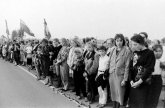Difference between revisions of "Baltic Unity"
(→Baltic Unity) |
|||
| Line 1: | Line 1: | ||
| − | === | + | === August 23rd === |
[[File:TBWAUGUST.jpg|400px|thumbnail|left]] | [[File:TBWAUGUST.jpg|400px|thumbnail|left]] | ||
The chorus of "The Singing Revolution" heard throughtout the Baltic.August 23rd: It was a form of protest unlike many seen in the Warsaw Bloc in the revolutionary months of 1989. Two million citizens of the Baltic States of Estonia, Latvia, and Lithuania linked hands and formed a human chain spanning over 400 miles. The seemingly endless line of people served as a symbol of Baltic unity and a protest of Soviet oppression.This unique protest became part of what will later be coined "The Singing Revolution", protests characterized by human chains and the spontaneous singing of national hymns and songs that were strictly forbidden by the Soviet government.The protests emerged on the heels of the 50th anniversary of the Soviet-Nazi Non Aggression Pact, an agreement which allowed the Soviet Union to annex the Baltic States into its territory. Mikhael Gorbachev's policy of perestroika had resulted in large, nationalist movements taking hold. Grassroots organizations such as the 'Sajudis movement in Lithuania and the Popular Fronts in Estonia and Latvia became massively popular and began to demand outright independence from the USSR. 6 months later, the Supreme Soviet of the Latvian SSR adopted a motion of a "Declaration of Indepdendence" and the Baltic States would formally push towards their goal of acting as free and independent Republics. | The chorus of "The Singing Revolution" heard throughtout the Baltic.August 23rd: It was a form of protest unlike many seen in the Warsaw Bloc in the revolutionary months of 1989. Two million citizens of the Baltic States of Estonia, Latvia, and Lithuania linked hands and formed a human chain spanning over 400 miles. The seemingly endless line of people served as a symbol of Baltic unity and a protest of Soviet oppression.This unique protest became part of what will later be coined "The Singing Revolution", protests characterized by human chains and the spontaneous singing of national hymns and songs that were strictly forbidden by the Soviet government.The protests emerged on the heels of the 50th anniversary of the Soviet-Nazi Non Aggression Pact, an agreement which allowed the Soviet Union to annex the Baltic States into its territory. Mikhael Gorbachev's policy of perestroika had resulted in large, nationalist movements taking hold. Grassroots organizations such as the 'Sajudis movement in Lithuania and the Popular Fronts in Estonia and Latvia became massively popular and began to demand outright independence from the USSR. 6 months later, the Supreme Soviet of the Latvian SSR adopted a motion of a "Declaration of Indepdendence" and the Baltic States would formally push towards their goal of acting as free and independent Republics. | ||
[[Category:Peacebuilding and Reconciliation]] | [[Category:Peacebuilding and Reconciliation]] | ||
Revision as of 08:04, 31 March 2014
August 23rd
The chorus of "The Singing Revolution" heard throughtout the Baltic.August 23rd: It was a form of protest unlike many seen in the Warsaw Bloc in the revolutionary months of 1989. Two million citizens of the Baltic States of Estonia, Latvia, and Lithuania linked hands and formed a human chain spanning over 400 miles. The seemingly endless line of people served as a symbol of Baltic unity and a protest of Soviet oppression.This unique protest became part of what will later be coined "The Singing Revolution", protests characterized by human chains and the spontaneous singing of national hymns and songs that were strictly forbidden by the Soviet government.The protests emerged on the heels of the 50th anniversary of the Soviet-Nazi Non Aggression Pact, an agreement which allowed the Soviet Union to annex the Baltic States into its territory. Mikhael Gorbachev's policy of perestroika had resulted in large, nationalist movements taking hold. Grassroots organizations such as the 'Sajudis movement in Lithuania and the Popular Fronts in Estonia and Latvia became massively popular and began to demand outright independence from the USSR. 6 months later, the Supreme Soviet of the Latvian SSR adopted a motion of a "Declaration of Indepdendence" and the Baltic States would formally push towards their goal of acting as free and independent Republics.
